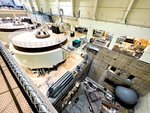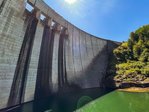





Clarence Lupo said he won the lottery three times: first when he was born an American citizen, a second time when he married his wife and a third time when he began his career as a hydroelectric project mechanic at the Mossyrock Dam.
He prefers to call himself a “hydro maniac.”
Lupo, 60, of Cinebar, grew up in Yelm. He’s been working for the Cowlitz River Hydroelectricity Project for over 30 years. Even after all this time, his passion for the work is unmistakable.
After creating a relationship with the newspaper by sending colorful photos of the sun rising over Riffe Lake, Lupo offered to take reporters from The Chronicle on a tour of the dam and powerhouse along with Monika Sundbaum, spokesperson for Tacoma Public Utilities, Kyrra Wilson, wildlife and recreation lands officer and cultural resource program manager, and Chad Chalmers, Cowlitz River hydro project manager.
The tour took place on the first day of summer, both on the calendar and in terms of weather.
The Cowlitz River project, owned by Tacoma City Light, began in the 1960s with Mayfield Dam forming 13-mile Mayfield Lake. Mossyrock Dam, built in 1968, forms the 23.5-mile-long Riffe Lake.
Seeing the dam from its reservoir, it already looks big. But the enormity of the machine doesn’t come into perspective until it’s seen from the other side.
Mossyrock Dam is the tallest dam in Washington. From the bedrock to the top, it’s 606 feet high — taller than the Space Needle. About 200 of those concrete feet are below the surface of the Cowlitz River, so even from the back side of the dam, one is only seeing about two thirds of the whole thing.
From the top, Lupo dropped a large rock into the river below, which took several seconds to hit the water. When it did, it sounded like a firework going off.
“The thing that impresses me the most about structures like this is now, we sit down with computer graphing calculators, computer models, and we work out every little formula to the nth degree. The people that built this sat down with a sharp pencil, a blank piece of paper, and did all the math long hand,” Lupo said. “I mean, it's just, holy smokes.”
The dam supplies power to the City of Tacoma, indirectly. Lupo explained Bonneville Power’s grid as being sort of like a lake. If one person takes water from one side while another supplies water on the other side, the total amount of water is unaffected, even though the exact water molecules being dumped by person two are not technically being collected by person one.
In the same sense, the actual electricity generated by the dam may be turning on a light switch in California, because the electricity there is pulled from the same grid that Tacoma City Light’s hydroelectricity projects feed into.
The Design of the Dam
Five people died while the Mossyrock Dam was being built, some from a crane accident, some from falling off scaffolding. Contrary to a persistent rumor, there are no bodies buried beneath the dam, as all were recovered, Lupo said. When it was built in the ‘60s, it was on the cutting edge of infrastructure design. It was the first dam ever built using a TV screen that showed where pieces needed to be placed.
The concrete slurry being mixed for the structure needed to be kept cool to maintain its strength, so instead of being created with water, it was done with massive amounts of shaved ice. There was a small building near the dam site just dedicated to creating large blocks of ice during construction.
While some hydroelectric dams have a “run of the river design,” as Monika Sundbaum, spokesperson for Tacoma Public Utilities, put it, where the motion of the river turns the cogs
that create electricity, the Mossyrock Dam is different. Large tubes from the lake feed into a reservoir with giant turbines. When they turn, electricity is created.
The more water that is in the reservoir, the more power the facility can generate. However, after the impending Cascadia Subduction Zone 9.0 earthquake was discovered to be a looming threat for the Pacific Northwest, the reservoir levels were lowered to decrease flood damage in case the dam were to be taken out by a disaster.
Studies on the dam’s outcome in such an earthquake are currently underway.
To lower water in the lake, the dam has three spill gates. When open, they make up a waterfall unrivaled by any other in Lewis County. The gates are opened once a month as a safety check.
In the early 2000s, the dam underwent a rebuild. Lupo took apart equipment, revealing pieces of the machinery that hadn’t been seen since 1968 and marveled at the excellent craftsmanship.
“I want to be in the same league as those guys,” he said. “The people who bolted those together knew, ‘No one's going to see this in my lifetime. It’s going to be together 50 to 75 years.’ We took those components apart. The welds are beautiful. Those things were welded by master craftsmen. … In a few years, when somebody comes behind me, maybe they’ll go through the notes and say, ‘Oh, Clarence worked on this!’ And they’re not going to say, ‘Oh God. Clarence worked on this.’”
The Powerhouse
When Lupo clocks in, the first thing he does is make sure the dam is still standing. So far, he’s always made it past this check.
The next thing he does is a visual inspection to make sure no water is coming out of an unusual spot and that the waterfalls and diversion tunnels near the dam are behaving as they should.
Then, depending on the time of day, week, month or year, he runs other safety tests. When stuff breaks, he fixes it. And when there’s a problem at the project at 3 a.m., he’s the one who gets a call.
Often, his job isn’t so different from a mechanic at a car shop, he said, but his qualifications as a hydro mechanic are necessary on occasion. Plus, it's easier to hire someone more experienced than to train someone inexperienced in the middle of an emergency, he said.
Inside the powerhouse — which is somehow even more nerve-wracking to stand at the top of than the dam, with a steep drop to a concrete floor — tubes large enough to drive a school bus through feed into the electricity-making turbines. There are two, both making around $40,000 to $60,000 worth of electricity per hour, depending on the market. The dam was originally fitted to have three, but the third was never completed.
The dam itself relies on its own power, and is fitted with backup generators and batteries in case of an emergency.
‘Holy Ground’
When asked what makes him most proud about his career, Lupo said, “that’s an easy question.”
“To me, it's a little bit of holy ground. There's five people that died making this thing. And it supplies electricity and supplies it probably right now about the most environmentally-friendly way we have to do in bulk electricity. … We saw, what, a couple dozen boats out there fishing? Nobody’s doing that at Hanford.”
Chalmers said he believes all the Cowlitz Project staff, including those at the hatcheries and Mayfield Dam, feel that way about the work.
Lupo said he meant no offense to his colleagues on the tour who live in Tacoma, but he loves stepping outside his workplace and taking a deep breath of fresh air. From the top of the dam, he watches the sunrise over the lake and looks down on bald eagles from above.
With the dam’s security footage, he can even spy on nesting pairs of peregrine falcons who make their homes at the dam.